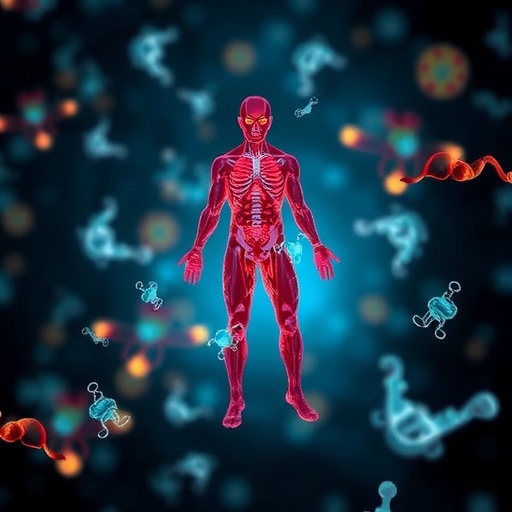In a groundbreaking meta-analysis published in BMC Cancer, researchers have unveiled a compelling link between male-origin microchimerism (MOM)—where small populations of male cells are found in women, presumably from prior pregnancies—and a significantly reduced risk of various cancers. This comprehensive study systematically evaluated data from multiple investigations to understand how the presence of these microchimeric cells influences cancer susceptibility among postpartum women, promising a new frontier in oncological and immunological research.
Microchimerism is a biological phenomenon characterized by the presence of a small number of genetically distinct cells within an individual. In females, MOM refers specifically to male cells that have crossed the placental barrier during pregnancy and persisted in maternal tissues and circulation long after childbirth. These fetal-origin cells have been detected across numerous studies, but their precise role, especially in cancer risk modulation, has remained elusive—until now.
The research team conducted an exhaustive review of three major scientific databases—PubMed, EMBASE, and Web of Science—scrutinizing numerous epidemiological studies that investigated the intersection of MOM and cancer risk. The meta-analysis aggregated data from 12 distinct studies encompassing a total of 3,078 female participants, allowing a statistically robust examination of this complex biological relationship.
Remarkably, this pooled analysis revealed that women harboring MOM exhibited a roughly 49% lower risk of developing cancer compared to those without detectable male-origin cells. This risk reduction was consistent across several cancer types, including breast, colon, ovarian, endometrial, thyroid, and brain cancers, hinting at a broad protective effect transcending organ-specific oncogenesis.
The mechanisms behind MOM’s protective influence against cancer are multifaceted and potentially linked to immunosurveillance. Researchers speculate that these microchimeric fetal cells may act as sentinels within maternal tissues, enhancing immune detection and eradication of emerging malignancies. Their foreign genetic identity may stimulate long-lasting immune vigilance, effectively surveilling and suppressing neoplastic transformation.
Additionally, MOM cells could contribute to tissue repair and regeneration, promoting healthy cellular turnover that counters oncogenic mutations. This regenerative capacity may be especially relevant in rapidly proliferative tissues such as breast and endometrial linings, offering another layer of anti-cancer defense through maintenance of tissue integrity and function.
Advanced statistical methodologies were employed in the meta-analysis, including random-effects models accommodating inter-study variability. This approach ensured the synthesis of heterogeneous study designs and populations, lending credibility to the reported pooled relative risk (RR) metric and its confidence intervals. Subgroup and sensitivity analyses reinforced the stability and reliability of the findings, mitigating concerns of publication bias or study-specific confounders.
The notion that fetal-origin cells retained long after pregnancy could impact the mother’s cancer susceptibility invites a paradigm shift in how maternal-fetal relationships are understood. Traditionally viewed through the lens of reproductive biology, microchimerism now emerges as a compelling crossroad of immunology, oncology, and regenerative medicine, highlighting the intricate cellular dialogues exchanged between mother and child.
From a clinical perspective, the detection of MOM may develop into a novel biomarker indicating cancer risk stratification among women. Non-invasive assays designed to detect circulating male-derived cells could inform personalized screening protocols, while therapeutics emulating or enhancing MOM’s protective impact might become a future avenue in cancer prevention strategies.
These findings also prompt deeper inquiries into the durability of MOM’s protective effects over time. Longitudinal research could clarify whether these microchimeric cells persist lifelong and how their quantitative presence correlates with evolving cancer risks as women age, particularly given the known influence of reproductive history on oncologic outcomes.
Moreover, this study opens questions about how microchimeric dynamics differ in women without male pregnancies or those adopting alternative pregnancy modalities such as assisted reproductive technologies. Comparative analyses could elucidate whether the microchimeric niche differs quantitatively or qualitatively across diverse reproductive contexts.
Intriguingly, the cross-talk between MOM and maternal immune systems may parallel phenomena observed in graft-versus-host scenarios following transplantation, where donor cells exert immune surveillance effects. Understanding these analogies could reveal novel immunotherapeutic principles inspired by natural microchimerism.
Despite these promising revelations, the authors emphasize caution. While the inverse association between MOM and cancer risk is statistically significant, causality remains to be definitively proven. Future mechanistic studies integrating molecular, immunological, and clinical data are needed to untangle the pathways by which fetal microchimerism attenuates malignant transformation.
The study’s comprehensive synthesis represents a vital step towards appreciating microchimerism not just as a biological curiosity but as a functional entity with profound implications for women’s health. It invites the scientific community to revolutionize paradigms around cancer prevention and immunosurveillance, integrating the symbiotic cellular legacies of pregnancy into the broader tapestry of oncology.
With cancer continuing to be one of the leading global health challenges, discoveries like these offer renewed hope. Understanding the natural protective mechanisms embedded within female biology, such as MOM, may unlock innovative approaches leveraging endogenous cellular interactions to suppress malignancy and improve outcomes.
As the authors conclude, “Individuals harboring male-origin microchimerism exhibit a significantly lower risk of cancer,” underscoring the clinical and biological significance of these microscopic genetic passengers threading through maternal tissue landscapes. The promise of microchimerism research is vast, poised to reshape the future of cancer epidemiology, immunology, and personalized medicine profoundly.
Future research expanding on this foundation will no doubt illuminate further nuances of this fascinating biological interplay. In the meantime, this meta-analysis marks a pivotal moment, inviting scientists, clinicians, and the public alike to reconsider the enduring legacy of pregnancy beyond reproduction, recognizing the potential cancer-fighting comrades residing within.
Subject of Research: The relationship between male-origin microchimerism and cancer risk among postpartum women.
Article Title: Male-origin microchimerism and risk of cancer: a systematic review and meta‑analysis
Article References: Li, J., Shao, T., Kou, J. et al. Male-origin microchimerism and risk of cancer: a systematic review and meta‑analysis. BMC Cancer 25, 1528 (2025). https://doi.org/10.1186/s12885-025-14860-z
Image Credits: Scienmag.com
DOI: https://doi.org/10.1186/s12885-025-14860-z
Tags: cancer risk reductioncancer susceptibility factorsepidemiological meta-analysisfemale health researchfetal-origin cellsimmunological implications of microchimerismmale-origin microchimerismmaternal tissue studiesmicrochimerism in womenoncological research advancementsplacental barrier studiespostpartum health





